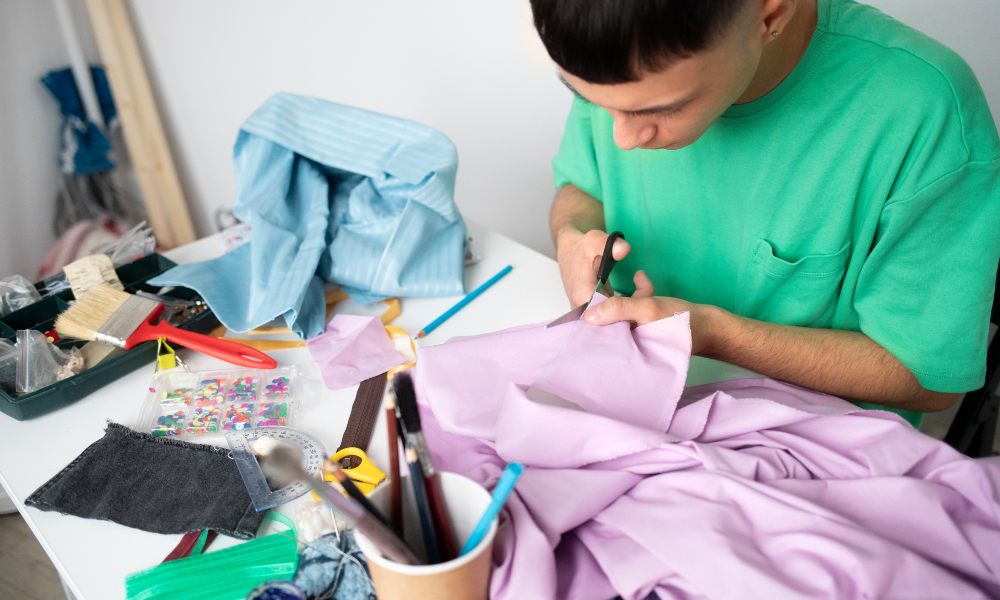Sewing is an art form passed down through generations, and mastering the correct pronunciation of “sew” is a crucial step in your sewing journey. Whether you’re a seasoned seamstress or a beginner, understanding how to articulate this simple yet essential term properly will enhance your confidence and credibility in the sewing community.
- Pronounce “sew” as a single syllable: “soh.”
- Emphasize the long “o” sound
- Avoid confusing it with “so” or “saw”
- Practice slowly, exaggerating the long “o” sound
- Listen to yourself and mimic sewing instructors
- Embrace the sewing community’s terminology
Ready to elevate your sewing game? Let’s dive into the intricacies of pronouncing “sew” like a pro!
The Roots of “Sew”
To truly grasp the essence of this word, we must explore its linguistic origins. Derived from the Old English “siwian,” the term “sew” has been woven into the fabric of our language for centuries. Its journey through time has been as intricate as the stitches it describes, each iteration adding nuance and depth to its pronunciation.
The Evolution of Pronunciation
While the written form of “sew” has remained relatively unchanged, its spoken rendition has undergone subtle transformations. In the early modern English era, the word was often pronounced with a more pronounced “ew” sound, akin to “sue.” However, as the language evolved, the pronunciation shifted to the long “o” sound we recognize today.
Regional Variations
Like many words in the English language, the pronunciation of “sew” can vary depending on regional dialects and accents. You may hear a slight diphthong in some areas, with the “o” sound blending into a softer “oo” at the end. While these variations add richness to the language, understanding the standard pronunciation is essential for clear communication in the sewing world.
Why Proper Pronunciation Matters

Mastering the correct pronunciation of “sew” extends beyond mere semantics. It has significant implications for your sewing journey and connections within the sewing community.
Avoiding Confusion and Miscommunication
Mispronouncing “sew” can lead to confusion and miscommunication, particularly in sewing circles where precise terminology is crucial. Whether you’re following a pattern, participating in a sewing class, or collaborating with fellow sewists, proper pronunciation ensures that your instructions and discussions are accurately understood.
Demonstrating Professionalism and Attention to Detail
Sewing is a craft that demands meticulous attention to detail, and your pronunciation of critical terms reflects your commitment to excellence. By articulating “sew” correctly, you demonstrate professionalism and respect for the art form, setting you apart as a dedicated and knowledgeable sewist.
Building Confidence in Your Sewing Skills
Confidence is a crucial component of any creative pursuit, and mastering the pronunciation of “sew” can boost your self-assurance as a sewist. When you confidently articulate this fundamental term, you reinforce your understanding of the craft and your ability to easily navigate its intricacies.
Embracing the Sewing Community
Sewing extends beyond being merely a hobby or skill; it forms a lively community that crosses borders and generations. By pronouncing “sew” correctly, you demonstrate your respect for the craft’s traditions and terminology, fostering a sense of belonging among fellow sewists.
Facilitating Seamless Communication
Within the sewing community, clear communication is essential. Whether attending a sewing circle, participating in an online forum, or collaborating on a project, correctly pronouncing “sew” ensures that your message is understood and your expertise is recognized.
Showing Respect for Traditions and Terminology
The sewing community is rich in history and traditions; its terminology reflects this heritage. By embracing the proper pronunciation of “sew,” you honor the craft’s legacy and demonstrate your commitment to preserving its authenticity.
Fostering a Sense of Belonging
When you pronounce “sew” correctly, you signal your membership in the sewing community. This mutual understanding fosters a connection among sewists, nurturing a feeling of camaraderie and respect that goes beyond individual skill levels or backgrounds.
FAQs
Is there a difference between “sew” and “sow”?
Yes, there is a distinct difference between these two words. “Sew” denotes stitching or connecting fabric, whereas “sow” is linked to planting seeds or birthing offspring. The pronunciation of “sow” has a longer “o” sound and rhymes with “low.”
Is “sew” pronounced differently in different regions?
While the standard pronunciation emphasizes the long “o” sound, there can be slight variations in regional dialects and accents. Some areas may blend the “o” into a softer “oo” sound, while others may have a more pronounced diphthong. However, the long “o” sound remains the widely accepted standard.
How can I practice pronouncing “sew” correctly?
Repetition and active listening are vital to mastering the pronunciation of “sew.” Try saying the word slowly and exaggerating the long “o” sound. Record yourself and listen for accuracy. Watch sewing tutorials or interact with experienced sewists to mimic their pronunciation.
Why is it important to pronounce “sew” correctly in the sewing community?
Proper pronunciation of “sew” is essential in the sewing community for several reasons: it avoids confusion and miscommunication, demonstrates professionalism and attention to detail, builds confidence in one’s sewing skills, facilitates seamless communication, shows respect for traditions and terminology, and fosters a sense of belonging among fellow sewists.
Can mispronouncing “sew” negatively impact my sewing journey?
While a mispronunciation may seem minor, it can undermine your credibility and hinder effective communication within the sewing community. By taking the time to master the correct pronunciation, you demonstrate your commitment to the craft and your respect for its traditions and terminology.
***
Don’t let a simple mispronunciation undermine your sewing prowess. Practice the proper way to say “sew,” and seamlessly weave into the vibrant world of needlework. Ready to take your sewing skills to the next level and confidently embrace the sewing community? Let your newfound pronunciation mastery be the first stitch in your latest creation!
***
Main image: pexels




